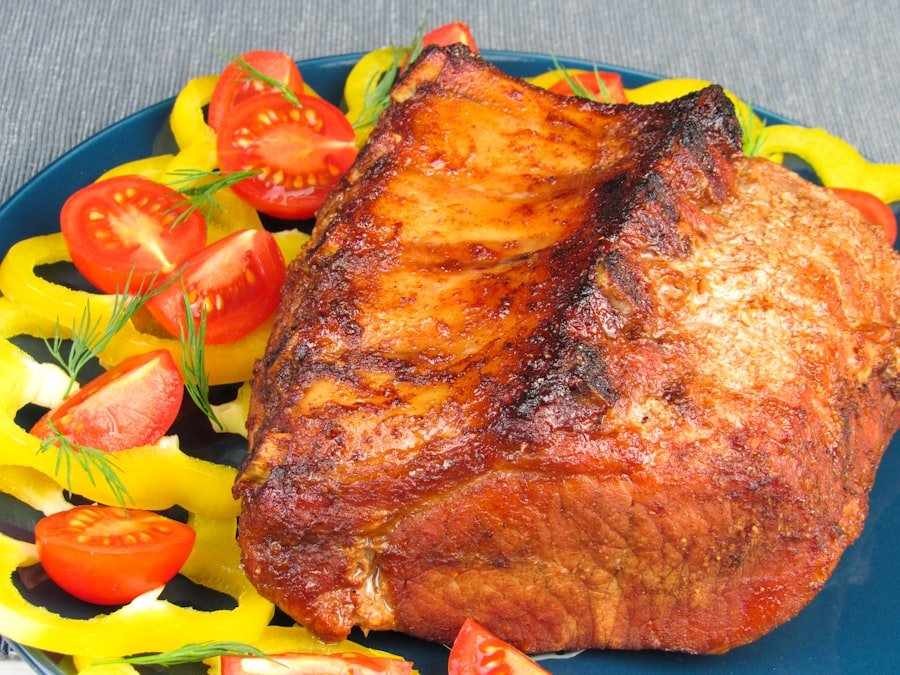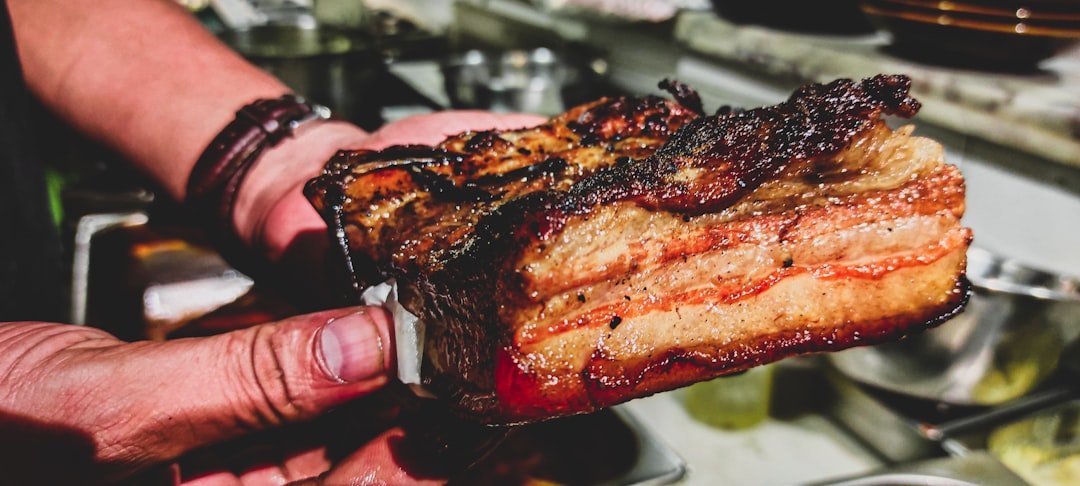When selecting pork tenderloin for grilling, several factors should be considered to ensure optimal results. Pork tenderloin is a lean cut derived from the muscle along the backbone. Ideal characteristics include a pale pink color with marbling, which contributes to flavor and juiciness during cooking.
A uniform size and shape are essential for even cooking. It is preferable to choose a tenderloin that has been trimmed of excess fat and silver skin, enhancing the eating experience. The source of the meat is also significant, with sustainably and ethically raised pork often providing superior taste and supporting responsible farming practices.
Consumers are encouraged to inquire about the meat’s origin and production methods, whether purchasing from a local butcher or grocery store. Selecting a high-quality pork tenderloin is fundamental to creating a flavorful and succulent grilled dish.
Key Takeaways
- Choose a pork tenderloin cut that is uniform in size and shape for even cooking
- Trim excess fat and silver skin from the pork tenderloin before grilling to prevent flare-ups
- Season the pork tenderloin with a dry rub or marinade at least 30 minutes before grilling for maximum flavor
- Preheat the grill to medium-high heat and set up direct and indirect heat zones for optimal cooking
- Grill the pork tenderloin for 15-20 minutes, turning occasionally, until the internal temperature reaches 145°F
- Let the grilled pork tenderloin rest for 5-10 minutes before slicing to allow the juices to redistribute
- Serve the grilled pork tenderloin with your favorite sides and enjoy a delicious meal
Preparing the Pork Tenderloin for Grilling
Trimming the Excess
Before seasoning and marinating the pork tenderloin, it’s essential to trim any excess fat and silver skin from the meat. This step not only improves the appearance of the pork tenderloin but also ensures that it cooks evenly on the grill. To trim the pork tenderloin, use a sharp knife to carefully remove any visible fat and silver skin, being careful not to remove too much of the meat in the process.
Drying the Meat
After trimming the pork tenderloin, it’s a good idea to pat the meat dry with paper towels. This helps the seasoning and marinade adhere to the surface of the pork tenderloin more effectively. Additionally, drying the meat promotes better browning and caramelization on the grill, resulting in a more flavorful and visually appealing dish.
Seasoning and Marinating for Success
Once the pork tenderloin is dry, you can move on to seasoning and marinating the meat to enhance its natural flavors and ensure a juicy and tender end result. By taking the time to properly prepare the pork tenderloin for grilling, you can set yourself up for success and create a dish that will impress even the most discerning of palates.
Seasoning and Marinating the Pork Tenderloin

Seasoning and marinating the pork tenderloin is an essential step in creating a flavorful and juicy grilled dish. When it comes to seasoning, simplicity is key. A classic combination of salt, pepper, and garlic powder is all you need to enhance the natural flavors of the pork tenderloin without overpowering them.
Be sure to season the pork tenderloin generously on all sides, rubbing the seasoning into the meat to ensure even coverage. If you’re feeling adventurous, you can also experiment with different spice blends and herbs to create a unique flavor profile for your grilled pork tenderloin. In addition to seasoning, marinating the pork tenderloin can add an extra layer of flavor and juiciness to the meat.
A simple marinade of olive oil, soy sauce, honey, and Dijon mustard is a great starting point for enhancing the flavor of the pork tenderloin. You can also add aromatics such as garlic, onion, and fresh herbs to infuse even more flavor into the meat. When marinating the pork tenderloin, be sure to place it in a resealable plastic bag or shallow dish and refrigerate it for at least 2 hours, or preferably overnight, to allow the flavors to penetrate the meat.
By taking the time to season and marinate the pork tenderloin before grilling, you can elevate its natural flavors and create a dish that is sure to impress your guests.
Preheating the Grill and Setting Up the Zones
| Zone | Temperature | Time |
|---|---|---|
| Direct Heat | High (450-550°F) | 10-15 minutes |
| Indirect Heat | Medium (350-450°F) | 10-15 minutes |
Before grilling the pork tenderloin, it’s important to preheat your grill and set up different heat zones to ensure even cooking and perfect doneness. Start by preheating your grill to medium-high heat, around 375-400°F. This will create a nice sear on the outside of the pork tenderloin while allowing it to cook through evenly.
Once your grill is preheated, it’s time to set up different heat zones by creating both direct and indirect heat areas on the grill. To set up direct heat zones, simply leave one side of the grill with all burners on while leaving the other side off. This will create a hot zone for searing the pork tenderloin before moving it to a cooler area for gentle cooking.
The indirect heat zone will allow the pork tenderloin to cook through without burning on the outside. By setting up different heat zones on your grill, you can ensure that your pork tenderloin cooks evenly and reaches the perfect level of doneness without overcooking or drying out. In addition to setting up heat zones, it’s important to clean and oil your grill grates before cooking the pork tenderloin.
This will prevent sticking and ensure beautiful grill marks on the meat. By preheating your grill and setting up different heat zones, you can create the perfect environment for grilling a delicious and juicy pork tenderloin.
Grilling the Pork Tenderloin: Timing and Temperature
Grilling pork tenderloin requires careful attention to timing and temperature to ensure that it cooks through evenly while remaining juicy and flavorful. Start by placing the seasoned and marinated pork tenderloin on the hot side of the grill to sear all sides for about 2-3 minutes per side. This will create a beautiful crust on the outside of the meat while locking in its natural juices.
After searing, move the pork tenderloin to the cooler side of the grill and close the lid. Let it cook for about 15-20 minutes, turning occasionally, until it reaches an internal temperature of 145°F. It’s important to use a meat thermometer to check for doneness, as overcooking can result in dry and tough meat.
When grilling pork tenderloin, it’s important to resist the urge to constantly flip or move the meat around on the grill. Allow it to cook undisturbed for several minutes at a time before checking for grill marks or doneness. By paying attention to timing and temperature while grilling, you can ensure that your pork tenderloin turns out perfectly juicy and flavorful every time.
Resting and Slicing the Grilled Pork Tenderloin

Letting the Meat Rest
Resting allows the juices in the meat to redistribute, resulting in a juicier and more flavorful end result. Place the grilled pork tenderloin on a cutting board and tent it loosely with aluminum foil. Let it rest for about 5-10 minutes before slicing.
Slicing Against the Grain
When slicing grilled pork tenderloin, it’s important to cut against the grain to ensure tenderness. The grain refers to the direction in which muscle fibers run through the meat. By slicing against the grain, you can shorten these fibers and create a more tender eating experience.
Serving and Presentation
Use a sharp knife to slice the grilled pork tenderloin into ½-inch thick pieces, arranging them on a platter or individual plates for serving. By allowing the grilled pork tenderloin to rest before slicing and cutting against the grain, you can ensure that each bite is juicy, flavorful, and perfectly tender. Serving beautifully sliced grilled pork tenderloin is sure to impress your guests and make for a memorable dining experience.
Serving and Enjoying the Perfectly Grilled Pork Tenderloin
After all your hard work in selecting, preparing, seasoning, marinating, grilling, resting, and slicing your pork tenderloin, it’s time to finally enjoy your delicious creation! Serve your perfectly grilled pork tenderloin with your favorite sides such as roasted vegetables, mashed potatoes, or a fresh salad for a complete meal that is sure to impress. When serving grilled pork tenderloin, consider adding a finishing touch such as a drizzle of balsamic glaze or a sprinkle of fresh herbs for added flavor and visual appeal.
You can also offer different sauces or condiments on the side such as chimichurri, barbecue sauce, or mustard for guests to customize their dining experience. Whether you’re hosting a backyard barbecue or enjoying a family dinner at home, serving perfectly grilled pork tenderloin is sure to be a hit with everyone at the table. Take pride in your culinary skills and enjoy every bite of your delicious creation!
If you’re looking for tips on grilling pork tenderloin, you might want to check out this article on grilloffers.com. They offer a variety of grilling tips and recipes that can help you achieve the perfect pork tenderloin on the grill.

